- Home
- Edgar Allan Poe
The Works of Edgar Allan Poe — Volume 3 Page 26
The Works of Edgar Allan Poe — Volume 3 Read online
Page 26
CHAPTER 25
WE now found ourselves in the wide and desolate Antarctic Ocean, in alatitude exceeding eighty-four degrees, in a frail canoe, and with noprovision but the three turtles. The long polar winter, too, could notbe considered as far distant, and it became necessary that we shoulddeliberate well upon the course to be pursued. There were six or sevenislands in sight belonging to the same group, and distant from eachother about five or six leagues; but upon neither of these had we anyintention to venture. In coming from the northward in the _Jane Guy_ wehad been gradually leaving behind us the severest regions of ice--this,however little it maybe in accordance with the generally receivednotions respecting the Antarctic, was a fact--experience would notpermit us to deny. To attempt, therefore, getting back would befolly--especially at so late a period of the season. Only one courseseemed to be left open for hope. We resolved to steer boldly to thesouthward, where there was at least a probability of discovering otherlands, and more than a probability of finding a still milder climate.
So far we had found the Antarctic, like the Arctic Ocean, peculiarlyfree from violent storms or immoderately rough water; but our canoe was,at best, of frail structure, although large, and we set busily towork with a view of rendering her as safe as the limited means in ourpossession would admit. The body of the boat was of no better materialthan bark--the bark of a tree unknown. The ribs were of a tough osier,well adapted to the purpose for which it was used. We had fifty feetroom from stem to stern, from four to six in breadth, and in depththroughout four feet and a half-the boats thus differing vastly in shapefrom those of any other inhabitants of the Southern Ocean with whomcivilized nations are acquainted. We never did believe them theworkmanship of the ignorant islanders who owned them; and some daysafter this period discovered, by questioning our captive, that they werein fact made by the natives of a group to the southwest of the countrywhere we found them, having fallen accidentally into the hands of ourbarbarians. What we could do for the security of our boat was verylittle indeed. Several wide rents were discovered near both ends, andthese we contrived to patch up with pieces of woollen jacket. With thehelp of the superfluous paddles, of which there were a great many, weerected a kind of framework about the bow, so as to break the force ofany seas which might threaten to fill us in that quarter. We also setup two paddle-blades for masts, placing them opposite each other, oneby each gunwale, thus saving the necessity of a yard. To these masts weattached a sail made of our shirts-doing this with some difficulty, ashere we could get no assistance from our prisoner whatever, although hehad been willing enough to labor in all the other operations. The sightof the linen seemed to affect him in a very singular manner. He couldnot be prevailed upon to touch it or go near it, shuddering when weattempted to force him, and shrieking out, _“Tekeli-li!”_
Having completed our arrangements in regard to the security of thecanoe, we now set sail to the south-southeast for the present, with theview of weathering the most southerly of the group in sight. This beingdone, we turned the bow full to the southward. The weather could by nomeans be considered disagreeable. We had a prevailing and very gentlewind from the northward, a smooth sea, and continual daylight. No icewhatever was to be seen; _nor did I ever see one particle of this afterleaving the parallel of Bennet’s Islet. _Indeed, the temperature of thewater was here far too warm for its existence in any quantity. Havingkilled the largest of our tortoises, and obtained from him not only foodbut a copious supply of water, we continued on our course, without anyincident of moment, for perhaps seven or eight days, during which periodwe must have proceeded a vast distance to the southward, as the windblew constantly with us, and a very strong current set continually inthe direction we were pursuing.
_March 1st_. {*7}-Many unusual phenomena now--indicated that we wereentering upon a region of novelty and wonder. A high range of lightgray vapor appeared constantly in the southern horizon, flaring upoccasionally in lofty streaks, now darting from east to west, now fromwest to east, and again presenting a level and uniform summit--in short,having all the wild variations of the Aurora Borealis. The averageheight of this vapor, as apparent from our station, was abouttwenty-five degrees. The temperature of the sea seemed to be increasingmomentarily, and there was a very perceptible alteration in its color.
_March 2d._-To-day by repeated questioning of our captive, we cameto the knowledge of many particulars in regard to the island of themassacre, its inhabitants, and customs--but with these how can I nowdetain the reader? I may say, however, that we learned there were eightislands in the group--that they were governed by a common king, named_Tsalemon _or _Psalemoun, _who resided in one of the smallest of theislands; that the black skins forming the dress of the warriors camefrom an animal of huge size to be found only in a valley near the courtof the king--that the inhabitants of the group fabricated no other boatsthan the flat-bottomed rafts; the four canoes being all of the kind intheir possession, and, these having been obtained, by mere accident,from some large island in the southwest--that his own name was Nu-Nu--thathe had no knowledge of Bennet’s Islet--and that the appellation of theisland he had left was Tsalal. The commencement of the words _Tsalemon_and Tsalal was given with a prolonged hissing sound, which we foundit impossible to imitate, even after repeated endeavors, and which wasprecisely the same with the note of the black bittern we had eaten up onthe summit of the hill.
_March 3d._-The heat of the water was now truly remarkable, and in colorwas undergoing a rapid change, being no longer transparent, but of amilky consistency and hue. In our immediate vicinity it was usuallysmooth, never so rough as to endanger the canoe--but we were frequentlysurprised at perceiving, to our right and left, at different distances,sudden and extensive agitations of the surface; these, we at lengthnoticed, were always preceded by wild flickerings in the region of vaporto the southward.
_March 4th._-To-day, with the view of widening our sail, the breeze fromthe northward dying away perceptibly, I took from my coat-pocket a whitehandkerchief. Nu-Nu was seated at my elbow, and the linen accidentallyflaring in his face, he became violently affected with convulsions.These were succeeded by drowsiness and stupor, and low murmurings of_“‘Tekeli-li! Tekeli-li!”_
_March _5th.-The wind had entirely ceased, but it was evident thatwe were still hurrying on to the southward, under the influence of apowerful current. And now,--indeed, it would seem reasonable that weshould experience some alarm at the turn events were taking--but wefelt none. The countenance of Peters indicated nothing of this nature,although it wore at times an expression I could not fathom. The polarwinter appeared to be coming on--but coming without its terrors. I felta numbness of body and mind--a dreaminess of sensation but this was all.
_March 6th._-The gray vapor had now arisen many more degrees above thehorizon, and was gradually losing its grayness of tint. The heat of thewater was extreme, even unpleasant to the touch, and its milky hue wasmore evident than ever. Today a violent agitation of the water occurredvery close to the canoe. It was attended, as usual, with a wild flaringup of the vapor at its summit, and a momentary division at its base. Afine white powder, resembling ashes--but certainly not such--fell over thecanoe and over a large surface of the water, as the flickering died awayamong the vapor and the commotion subsided in the sea. Nu-Nu now threwhimself on his face in the bottom of the boat, and no persuasions couldinduce him to arise.
_March 7th._-This day we questioned Nu-Nu concerning the motives ofhis countrymen in destroying our companions; but he appeared to be tooutterly overcome by terror to afford us any rational reply. He stillobstinately lay in the bottom of the boat; and, upon reiterating thequestions as to the motive, made use only of idiotic gesticulations,such as raising with his forefinger the upper lip, and displaying theteeth which lay beneath it. These were black. We had never before seenthe teeth of an inhabitant of Tsalal.
_March 8th._-To-day there floated by us one of the white animals whoseappearance upon the beach at Tsalal had occasioned so wild a commotionamong the savag
es. I would have picked it up, but there came over mea sudden listlessness, and I forbore. The heat of the water stillincreased, and the hand could no longer be endured within it. Petersspoke little, and I knew not what to think of his apathy. Nu-Nubreathed, and no more.
_March 9th._-The whole ashy material fell now continually around us,and in vast quantities. The range of vapor to the southward had arisenprodigiously in the horizon, and began to assume more distinctnessof form. I can liken it to nothing but a limitless cataract, rollingsilently into the sea from some immense and far-distant rampart inthe heaven. The gigantic curtain ranged along the whole extent of thesouthern horizon. It emitted no sound.
_March 21st._-A sullen darkness now hovered above us--but from out themilky depths of the ocean a luminous glare arose, and stole up alongthe bulwarks of the boat. We were nearly overwhelmed by the white ashyshower which settled upon us and upon the canoe, but melted into thewater as it fell. The summit of the cataract was utterly lost in thedimness and the distance. Yet we were evidently approaching it with ahideous velocity. At intervals there were visible in it wide, yawning,but momentary rents, and from out these rents, within which was a chaosof flitting and indistinct images, there came rushing and mighty, butsoundless winds, tearing up the enkindled ocean in their course.
_March 22d._-The darkness had materially increased, relieved only by theglare of the water thrown back from the white curtain before us. Manygigantic and pallidly white birds flew continuously now from beyond theveil, and their scream was the eternal _Tekeli-li! _as they retreatedfrom our vision. Hereupon Nu-Nu stirred in the bottom of the boat; butupon touching him we found his spirit departed. And now we rushed intothe embraces of the cataract, where a chasm threw itself open to receiveus. But there arose in our pathway a shrouded human figure, very farlarger in its proportions than any dweller among men. And the hue of theskin of the figure was of the perfect whiteness of the snow.
NOTE
THE circumstances connected with the late sudden and distressing deathof Mr. Pym are already well known to the public through the medium ofthe daily press. It is feared that the few remaining chapters which wereto have completed his narrative, and which were retained by him,while the above were in type, for the purpose of revision, have beenirrecoverably lost through the accident by which he perished himself.This, however, may prove not to be the case, and the papers, ifultimately found, will be given to the public.
No means have been left untried to remedy the deficiency. The gentlemanwhose name is mentioned in the preface, and who, from the statementthere made, might be supposed able to fill the vacuum, has declinedthe task--this, for satisfactory reasons connected with the generalinaccuracy of the details afforded him, and his disbelief in the entiretruth of the latter portions of the narration. Peters, from whomsome information might be expected, is still alive, and a resident ofIllinois, but cannot be met with at present. He may hereafter be found,and will, no doubt, afford material for a conclusion of Mr. Pym’saccount.
The loss of two or three final chapters (for there were but two orthree) is the more deeply to be regretted, as it can not be doubted theycontained matter relative to the Pole itself, or at least to regions inits very near proximity; and as, too, the statements of the author inrelation to these regions may shortly be verified or contradicted bymeans of the governmental expedition now preparing for the SouthernOcean.
On one point in the narrative some remarks may well be offered; and itwould afford the writer of this appendix much pleasure if what he mayhere observe should have a tendency to throw credit, in any degree, uponthe very singular pages now published. We allude to the chasms found inthe island of Tsalal, and to the whole of the figures upon pages 245-47{of the printed edition--ed.}.
(Note: No figures were included with this text)
Mr. Pym has given the figures of the chasms without comment, andspeaks decidedly of the _indentures _found at the extremity of themost easterly of these chasms as having but a fanciful resemblance toalphabetical characters, and, in short, as being positively _not such._This assertion is made in a manner so simple, and sustained by aspecies of demonstration so conclusive (viz., the fitting of theprojections of the fragments found among the dust into the indenturesupon the wall), that we are forced to believe the writer in earnest;and no reasonable reader should suppose otherwise. But as the facts inrelation to all the figures are most singular (especially when taken inconnection with statements made in the body of the narrative), it maybe as well to say a word or two concerning them all--this, too, the moreespecially as the facts in question have, beyond doubt, escaped theattention of Mr. Poe.
Figure 1, then, figure 2, figure 3, and figure 5, when conjoined withone another in the precise order which the chasms themselves presented,and when deprived of the small lateral branches or arches (which, itwill be remembered, served only as a means of communication between themain chambers, and were of totally distinct character), constitute anEthiopian verbal root--the root “To be shady,’--whence all theinflections of shadow or darkness.
In regard to the “left or most northwardly” of the indentures in figure4, it is more than probable that the opinion of Peters was correct,and that the hieroglyphical appearance was really the work of art,and intended as the representation of a human form. The delineationis before the reader, and he may, or may not, perceive the resemblancesuggested; but the rest of the indentures afford strong confirmationof Peters’ idea. The upper range is evidently the Arabic verbal root“To be white,” whence all the inflections of brilliancy andwhiteness. The lower range is not so immediately perspicuous. Thecharacters are somewhat broken and disjointed; nevertheless, it can notbe doubted that, in their perfect state, they formed the full Egyptianword, “The region of the south.” It should be observed thatthese interpretations confirm the opinion of Peters in regard to the“most northwardly” of the figures. The arm is outstretched toward thesouth.
Conclusions such as these open a wide field for speculation and excitingconjecture. They should be regarded, perhaps, in connection with someof the most faintly detailed incidents of the narrative; although in novisible manner is this chain of connection complete. Tekeli-li! was thecry of the affrighted natives of Tsalal upon discovering the carcaseof the _white _animal picked up at sea. This also was the shudderingexclamatives of Tsalal upon discovering the carcass of the _white_materials in possession of Mr. Pym. This also was the shriek of theswift-flying, _white, _and gigantic birds which issued from the vapory_white _curtain of the South. Nothing _white _was to be found at Tsalal,and nothing otherwise in the subsequent voyage to the region beyond. Itis not impossible that “Tsalal,” the appellation of the island of thechasms, may be found, upon minute philological scrutiny, to betrayeither some alliance with the chasms themselves, or some reference tothe Ethiopian characters so mysteriously written in their windings.
_“I have graven it within the hills, and my vengeance upon the dustwithin the rock.”_
Notes
{*1} Whaling vessels are usually fitted with iron oil-tanks--why the_Grampus_ was not I have never been able to ascertain.
{*2} The case of the brig _Polly_, of Boston, is one so much in point,and her fate, in many respects, so remarkably similar to our own, thatI cannot forbear alluding to it here. This vessel, of one hundred andthirty tons burden, sailed from Boston, with a cargo of lumber andprovisions, for Santa Croix, on the twelfth of December, 1811, under thecommand of Captain Casneau. There were eight souls on board besides thecaptain--the mate, four seamen, and the cook, together with a Mr. Hunt,and a negro girl belonging to him. On the fifteenth, having clearedthe shoal of Georges, she sprung a leak in a gale of wind from thesoutheast, and was finally capsized; but, the masts going by the board,she afterward righted. They remained in this situation, without fire,and with very little provision, for the period of one hundred andninety-one days (from December the fifteenth to June the twentieth),when Captain Casneau and Samuel Badger, the only survivors, were takenoff the wreck by the Fame, of Hu
ll, Captain Featherstone, bound homefrom Rio Janeiro. When picked up, they were in latitude 28 degrees N.,longitude 13 degrees W., having drifted above two thousand miles! On theninth of July the Fame fell in with the brig Dromero, Captain Perkins,who landed the two sufferers in Kennebeck. The narrative from which wegather these details ends in the following words:
“It is natural to inquire how they could float such a vast distance,upon the most frequented part of the Atlantic, and not be discovered allthis time. They were passed by more than a dozen sail, one of which cameso nigh them that they could distinctly see the people on deck and onthe rigging looking at them; but, to the inexpressible disappointment ofthe starving and freezing men, they stifled the dictates of compassion,hoisted sail, and cruelly abandoned them to their fate.”
{*3} Among the vessels which at various times have professed to meetwith the Auroras may be mentioned the ship San Miguel, in 1769; the shipAurora, in 1774; the brig Pearl, in 1779; and the ship Dolores, in 1790.They all agree in giving the mean latitude fifty-three degrees south.
{*4} The terms morning and evening, which I have made use of to avoidconfusion in my narrative, as far as possible, must not, of course, betaken in their ordinary sense. For a long time past we had had no nightat all, the daylight being continual. The dates throughout are accordingto nautical time, and the bearing must be understood as per compass. Iwould also remark, in this place, that I cannot, in the first portion ofwhat is here written, pretend to strict accuracy in respect to dates, orlatitudes and longitudes, having kept no regular journal until afterthe period of which this first portion treats. In many instances I haverelied altogether upon memory.
{*5} This day was rendered remarkable by our observing in the southseveral huge wreaths of the grayish vapour I have spoken of.
{*6} The marl was also black; indeed, we noticed no light coloredsubstances of any kind upon the island.
{*7}For obvious reasons I cannot pretend to strict accuracy inthese dates. They are given principally with a view to perspicity ofnarrative, and as set down in my pencil memorandum.

 The Works of Edgar Allan Poe — Volume 2
The Works of Edgar Allan Poe — Volume 2 The Works of Edgar Allan Poe — Volume 1
The Works of Edgar Allan Poe — Volume 1 The Works of Edgar Allan Poe — Volume 3
The Works of Edgar Allan Poe — Volume 3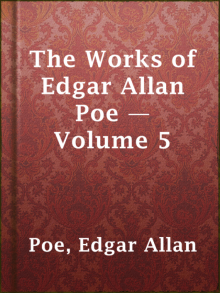 The Works of Edgar Allan Poe — Volume 5
The Works of Edgar Allan Poe — Volume 5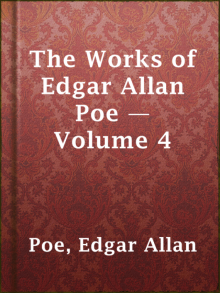 The Works of Edgar Allan Poe — Volume 4
The Works of Edgar Allan Poe — Volume 4 The Tell-Tale Heart
The Tell-Tale Heart The Raven (Penguin)
The Raven (Penguin) The Paris Mysteries
The Paris Mysteries Tales of Terror from Edgar Allan Poe
Tales of Terror from Edgar Allan Poe The Fall of the House of Usher
The Fall of the House of Usher The Golden Book of World's Greatest Mysteries
The Golden Book of World's Greatest Mysteries The Narrative of Arthur Gordon Pym of Nantucket
The Narrative of Arthur Gordon Pym of Nantucket Ligeia
Ligeia The Landscape Garden
The Landscape Garden Complete Tales & Poems
Complete Tales & Poems Great Tales and Poems of Edgar Allan Poe
Great Tales and Poems of Edgar Allan Poe The Colloquy of Monos and Una
The Colloquy of Monos and Una The Oblong Box
The Oblong Box Thou Art the Man
Thou Art the Man A DESCENT INTO THE MAELSTROM
A DESCENT INTO THE MAELSTROM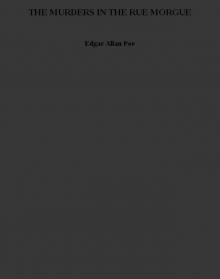 THE MURDERS IN THE RUE MORGUE
THE MURDERS IN THE RUE MORGUE The Business Man
The Business Man The Mystery of Marie Rogêt
The Mystery of Marie Rogêt Metzengerstein
Metzengerstein The Man That Was Used Up
The Man That Was Used Up William Wilson
William Wilson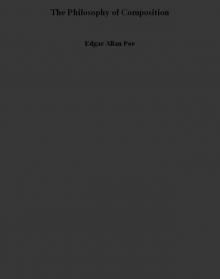 The Philosophy of Composition
The Philosophy of Composition The Portable Edgar Allan Poe
The Portable Edgar Allan Poe Bon-Bon
Bon-Bon A Predicament
A Predicament The Premature Burial
The Premature Burial The Angel of the Odd
The Angel of the Odd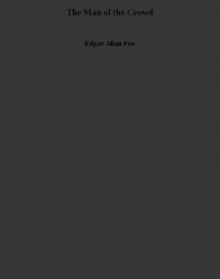 The Man of the Crowd
The Man of the Crowd Never Bet the Devil Your Head
Never Bet the Devil Your Head The Tell-Tale Heart and Other Writings
The Tell-Tale Heart and Other Writings The System of Doctor Tarr and Professor Fether
The System of Doctor Tarr and Professor Fether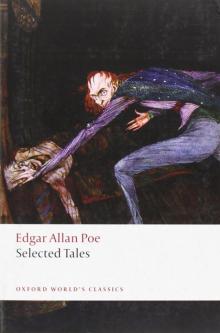 Selected Tales (Oxford World's Classics)
Selected Tales (Oxford World's Classics) Essential Tales and Poems of Edgar Allan Poe (Barnes & Noble Classics Series)
Essential Tales and Poems of Edgar Allan Poe (Barnes & Noble Classics Series) MS. Found in a Bottle
MS. Found in a Bottle Some Words with a Mummy
Some Words with a Mummy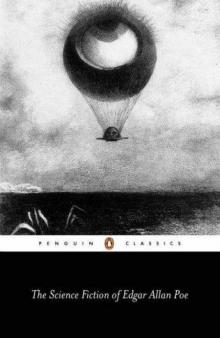 The Science Fiction of Edgar Allan Poe (Penguin Classics)
The Science Fiction of Edgar Allan Poe (Penguin Classics) King Pest
King Pest CRITICISM
CRITICISM How to Write a Blackwood Article
How to Write a Blackwood Article Mystification
Mystification Diddling Considered as One of the Exact Sciences
Diddling Considered as One of the Exact Sciences Steampunk Poe
Steampunk Poe The Literary Life of Thingum Bob, Esq.
The Literary Life of Thingum Bob, Esq.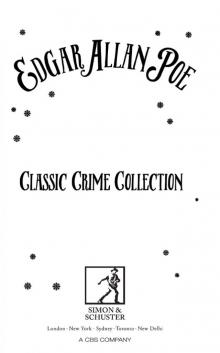 Classic Crime Collection
Classic Crime Collection Complete Stories and Poems of Edgar Allen Poe
Complete Stories and Poems of Edgar Allen Poe Berenice
Berenice The Black Cat
The Black Cat The Slender Poe Anthology
The Slender Poe Anthology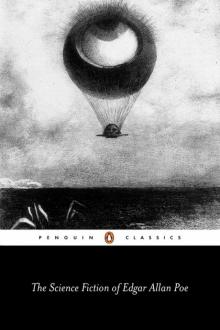 The Science Fiction of Edgar Allan Poe
The Science Fiction of Edgar Allan Poe The Assignation
The Assignation The Thousand-and-Second Tale of Scheherazade
The Thousand-and-Second Tale of Scheherazade The Raven and Other Short Stories
The Raven and Other Short Stories The Spectacles
The Spectacles Hop-Frog
Hop-Frog The Purloined Letter
The Purloined Letter Mellonta Tauta
Mellonta Tauta The Balloon-Hoax
The Balloon-Hoax Landor's Cottage
Landor's Cottage Mesmeric Revelation
Mesmeric Revelation The Pit and the Pendulum
The Pit and the Pendulum